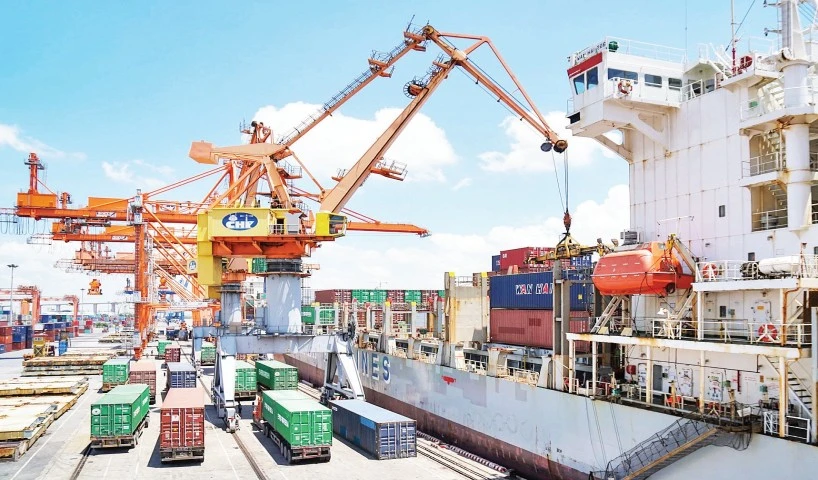Highlights on Viet Nam’s growth landscape
According to the socio-economic development report for the first half of 2025 released by the Ministry of Finance, Viet Nam's GDP grew by 7.31%, the highest rate for the same period in nearly 20 years.

Notably, among the six provinces and cities (out of 34 following administrative mergers) that posted double-digit growth, four are located in the Red River Delta region.
The provinces leading the country with double-digit growth rates are located in the Red River Delta region, including: Hai Phong (11.2%), Quang Ninh (11.03%), Ninh Binh (10.82%), and Bac Ninh (10.47%). To achieve these remarkable growth targets, from the beginning of the year, localities in the region have focused on formulating development strategies that ensure harmony and synchronisation across the industrial, agricultural, and trade-service sectors. Emphasis has been placed on boosting areas of strength that still offer significant growth potential, tailoured to the specific characteristics of each locality.
Hai Phong, leveraging its advantages in maritime economy and port infrastructure, has pursued a development strategy centered on three economic pillars including high-tech industry, seaport-logistics, and tourism-commerce. As a result, its industrial production index rose by 15.2% in the first half of 2025 compared to the same period in 2024.
During this period, Hai Phong established six industrial parks including Nomura 2, Vinh Quang, Trang Due 3, Nam Trang Cat, Tan Trao (Phase 1), and Ngu Phuc (Phase 1), spanning thousands of hectares, along with two industrial clusters of Tran Due and Cua Hoat–Quan Thang. The city is also aggressively advancing its logistics sector toward efficiency and sustainability. The logistics industry has consistently grown by over 20% annually, contributing about 15% to the city’s GRDP. Hai Phong currently hosts approximately 250 logistics firms employing over 170,000 people, with 60 major warehouses totaling over 700 hectares, mainly located in key port areas such as Dinh Vu, Tan Vu, Chua Ve, Hoang Dieu, and Hai An.
Sharing a same strength in industrial development, Bac Ninh’s industrial production index in the first half of 2025 rose by 10.46%, significantly driven by FDI enterprises and major industrial corporations. With competitive advantages in geographical location and preferential investment policies, Bac Ninh continues to attract both domestic and foreign investors, particularly large-scale industrial groups and multinational companies.
In the first half of 2025, the Bac Ninh Industrial Zones Authority granted new investment registration certificates to nearly 130 projects in the province’s industrial zones, with a total registered capital of 1.1489 billion USD. This included 86 foreign direct investment (FDI) projects with a total registered capital of 636.73 million USD, and 42 domestic direct investment (DDI) projects with a total capital of 12.804.23 trillion VND (equivalent to more than 510 million USD).
To secure its position among the top performers nationwide, Quang Ninh has strongly promoted its processing and manufacturing industries along with tourism services. In the first six months of the year, the industrial sector was estimated to grow by 8.57%, with the processing and manufacturing industries being the main contributors, posting a 23.81% increase year-on-year. The province welcomed an estimated 12.08 million tourists, up 16% compared to the same period in 2024, including approximately 2.275 million international visitors. Total tourism revenue is estimated at 29.14 trillion VND, an increase of 31% year-on-year.
Quang Ninh has not only become a prime destination for investors but also a magnet for international tourists, contributing to the province’s economic restructuring toward greater industrial and service development. Since the beginning of the year, Quang Ninh has received 35 international cruise ships, bringing nearly 50,000 cruise passengers, up 25% from the same period in 2024. Most of these tourists came from high-spending markets such as the US, Germany, the UK, France, Japan, and several other European and American countries. In the same period, Ninh Binh welcomed about 7.2 million visitors, including over 1 million international arrivals. Tourism revenue is estimated at 7.715 trillion VND, a 32% increase compared to the same period in 2024.
Notably, the number of overnight visitors reached nearly 1.4 million, up more than 21% compared to the same period in 2024. In June alone, Ninh Binh welcomed over 600,000 tourists, generating total revenue of 718 billion VND. This success stems from a range of tourism stimulus efforts by the province, leveraging its natural landscape advantages, and promoting sustainable tourism through distinctive programmes that connect nature with local communities.
According to economic experts, to meet the national growth target of 8% or higher in 2025, provinces and cities, particularly those in the Red River Delta, must continue to harness existing advantages and enhance regional and inter-local linkages. This includes maximising each locality’s strengths to form a collective momentum for growth, especially following the provincial mergers and the implementation of the two-tier local government model, which are expected to create new development opportunities.
Localities are also encouraged to effectively implement central directives and resolutions, with a focus on four strategic pillars: breakthroughs in science, technology, innovation and national digital transformation; international integration in the new context; reforms in legislative development and enforcement to meet national development demands in the new era; and fostering the private economic sector. These pillars are considered essential for future growth, not only for the Red River Delta but also for the entire country.








